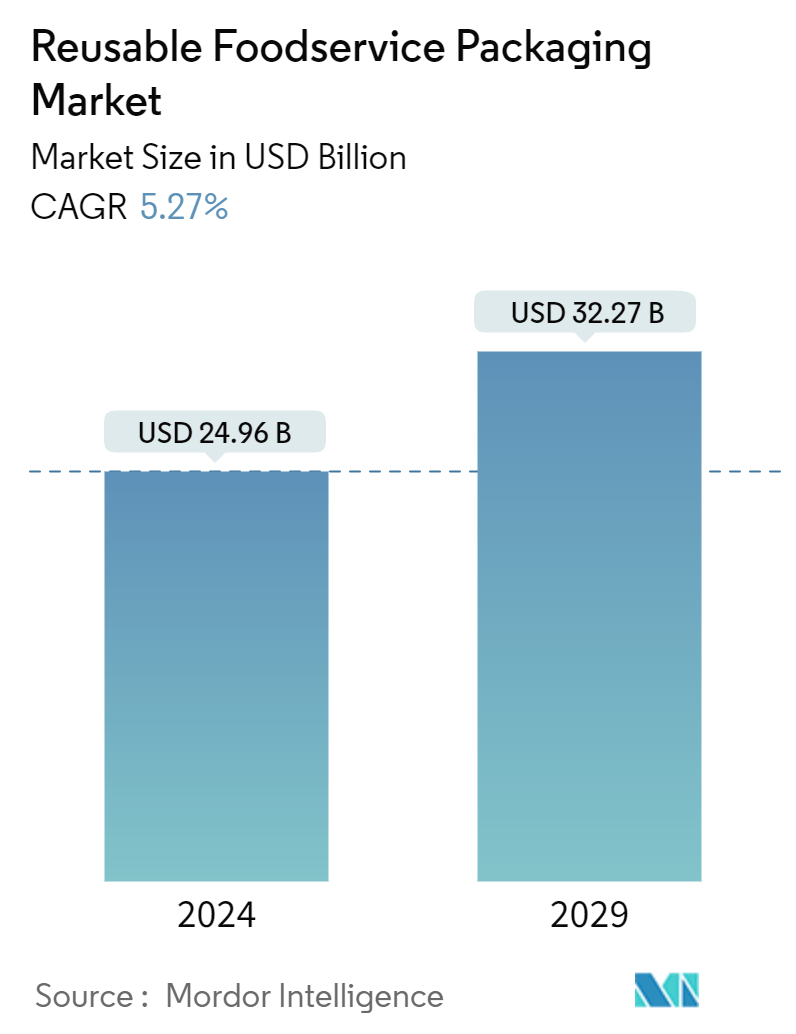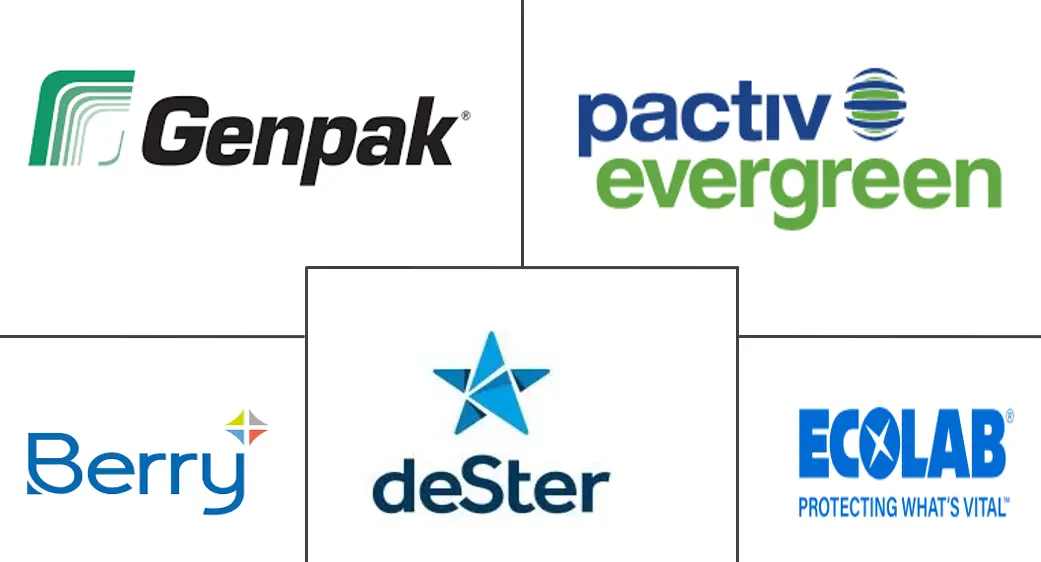Market Size of Reusable Foodservice Packaging Industry

| Study Period | 2019 - 2029 |
| Market Size (2024) | USD 24.96 Billion |
| Market Size (2029) | USD 32.27 Billion |
| CAGR (2024 - 2029) | 5.27 % |
| Fastest Growing Market | Asia Pacific |
| Largest Market | Asia Pacific |
| Market Concentration | Low |
Major Players
*Disclaimer: Major Players sorted in no particular order |
Reusable Foodservice Packaging Market Analysis
The Reusable Foodservice Packaging Market size is estimated at USD 24.96 billion in 2024, and is expected to reach USD 32.27 billion by 2029, growing at a CAGR of 5.27% during the forecast period (2024-2029).
The global reusable packaging market is set for significant growth, fueled by a rising need for durable and sustainable material handling solutions. Returnable packaging stands out for its pivotal role in sustainability, curbing the volume of packaging waste that typically ends up in landfills.
- A diverse urban landscape drives the country's demand for convenient, on-the-go, lightweight foods. In recent years, ready-to-eat and convenient food has evolved into one of the most diverse segments of the global food service, with rising concern about the environment and the escalation in packaging landfills, reusable food service packaging in hotels, full-service restaurants (FSRs), and quick-service restaurants (QSRs).
- Several government bodies worldwide impose strict guidelines for using reusable packaging across sectors. For instance, the SUP Directive mandates that EU Member States actively reduce single-use plastic waste, setting specific reduction targets at local and national levels. In tandem with restrictions, these states are advocating for reusable food packaging to achieve these goals.
- In France, recent legislation mandates that all on-site meals or snacks be consumed using reusable packaging or crockery.
- Over the past few years, the online food ordering and restaurant delivery sector has grown by 20%. As the online food delivery system gains traction, there is a corresponding surge in demand for sustainable food service packaging. As per the China Internet Network Information Center publication in March 2024, the number of online food delivery users in China rose from 418.83 million in 2020 to a whopping 544.54 million in 2023. This uptick is prompting manufacturers to pivot toward eco-friendly reusable packaging solutions.
- However, transitioning from a single-use to a reuse model for plastic packaging in industrial food applications can introduce unforeseen challenges, particularly in hygiene and sensory perception. Reusing plastic packaging carries the risk of heightening chemical contamination and the presence of microplastic particles in food products. Additionally, it may compromise the packaged goods' hygienic standards and sensory consistency.
- Globally, large companies are shifting from the traditional 'catch, fill, and waste' model to a zero-waste lifestyle. They achieve this by making foodservice packaging reusable, thus extending its lifecycle sustainably. This shift not only cuts down on operational costs tied to packaging but also eliminates the need for continual new packaging purchases.
Reusable Foodservice Packaging Industry Segmentation
Reusable packaging denotes containers and packaging materials crafted for multiple uses. This approach not only curtails waste but also offers a circular economy. Such solutions, known for their durability and efficiency, present an eco-friendly and sustainable substitute for conventional single-use packaging. Based on current trends and market dynamics, the study tracks and analyzes the demand for reusable packaging within the food service industry. The market numbers are derived by tracking the revenue generated by players providing reusable packaging products across the end-user industries. The study provides a detailed breakdown of the various types of material across different geographies.
The reusable foodservice market is segmented by material type (metal, plastic, glass, and other material types), product type (corrugated boxes and cartons, bottles and glasses, trays, plates, food containers, and bowls, cups and lids, clamshells, and other product types), end-user industry (quick-service restaurants {QSR}, full-service restaurants {FSR}, institutional, hospitality, and other end-user industries), geography (North America {United States, Canada}, Europe {United Kingdom, Germany, France, Italy, Spain, and Rest of Europe}, Asia-Pacific {China, India, Japan, Australia and New Zealand, and Rest of Asia-Pacific}, Latin America {Brazil, Mexico, Argentina, and Rest of Latin America}, Middle East and Africa {United Arab Emirates, Saudi Arabia, South Africa, and Rest of Middle East and Africa}). The report offers market sizes and forecasts in value (USD) for all the above segments.
| By Material Type | |
| Metal | |
| Plastic | |
| Glass | |
| Other Material Types |
| By Product Type | |
| Corrugated Boxes And Cartons | |
| Bottles and Glasses | |
| Trays, Plates, Food Containers, and Bowls | |
| Cups And Lids | |
| Clamshells | |
| Other Product Types |
| By End-user Industry | |
| Quick-service Restaurants (QSR) | |
| Full-service Restaurants (FSR) | |
| Institutional | |
| Hospitality | |
| Other End-user Industries |
| By Geography*** | |||||||
| |||||||
| |||||||
| |||||||
| |||||||
|
Reusable Foodservice Packaging Market Size Summary
The reusable foodservice packaging market is poised for substantial growth, driven by an increasing demand for sustainable and durable packaging solutions. This market expansion is largely attributed to the global shift towards reducing packaging waste and enhancing sustainability efforts across various sectors, including hotels, full-service restaurants, and quick-service restaurants. The rise of online food ordering and delivery services has further accelerated the demand for eco-friendly packaging, as consumers increasingly seek convenient and sustainable dining options. Government regulations, such as the EU's SUP Directive and France's legislation on reusable packaging, are also playing a crucial role in promoting the adoption of reusable packaging solutions, encouraging businesses to transition from single-use to reusable models.
In the Asia-Pacific region, the market is experiencing rapid growth due to urbanization, busy lifestyles, and a growing preference for on-the-go dining. Countries like China and India are witnessing a surge in demand for mobile food service stations and sustainable packaging solutions, driven by increased consumer spending on dining out and government initiatives to reduce plastic waste. The market is characterized by a fragmented landscape with numerous players, including major companies like Berry Global Inc., Ecolab Services, and Genpak LLC, who are focusing on innovative and sustainable packaging solutions. Recent developments, such as Berry Global's launch of a reusable tableware range and collaborations like deSter and Eastman's reusable in-flight drinkware, highlight the industry's commitment to meeting legislative standards and consumer demands for sustainable packaging alternatives.
Reusable Foodservice Packaging Market Size - Table of Contents
-
1. MARKET INSIGHTS
-
1.1 Market Overview
-
1.2 Industry Attractiveness - Porter's Five Forces Analysis
-
1.2.1 Bargaining Power of Suppliers
-
1.2.2 Bargaining Power of Buyers
-
1.2.3 Threat of Substitutes
-
1.2.4 Threat of New Entrants
-
1.2.5 Intensity of Competitive Rivalry
-
-
1.3 Industry Value Chain Analysis
-
1.4 Assessment of Impact of Recent Geopolitical Scenario on the Industry
-
1.5 Reusable vs Single-user Safer Solution in Current Scenario
-
-
2. MARKET SEGMENTATION
-
2.1 By Material Type
-
2.1.1 Metal
-
2.1.2 Plastic
-
2.1.3 Glass
-
2.1.4 Other Material Types
-
-
2.2 By Product Type
-
2.2.1 Corrugated Boxes And Cartons
-
2.2.2 Bottles and Glasses
-
2.2.3 Trays, Plates, Food Containers, and Bowls
-
2.2.4 Cups And Lids
-
2.2.5 Clamshells
-
2.2.6 Other Product Types
-
-
2.3 By End-user Industry
-
2.3.1 Quick-service Restaurants (QSR)
-
2.3.2 Full-service Restaurants (FSR)
-
2.3.3 Institutional
-
2.3.4 Hospitality
-
2.3.5 Other End-user Industries
-
-
2.4 By Geography***
-
2.4.1 North America
-
2.4.1.1 United States
-
2.4.1.2 Canada
-
-
2.4.2 Europe
-
2.4.2.1 United Kingdom
-
2.4.2.2 Germany
-
2.4.2.3 France
-
2.4.2.4 Italy
-
2.4.2.5 Spain
-
-
2.4.3 Asia-Pacific
-
2.4.3.1 China
-
2.4.3.2 Japan
-
2.4.3.3 India
-
2.4.3.4 Australia and New Zealand
-
-
2.4.4 Latin America
-
2.4.4.1 Brazil
-
2.4.4.2 Argentina
-
2.4.4.3 Mexico
-
-
2.4.5 Middle East and Africa
-
2.4.5.1 Saudi Arabia
-
2.4.5.2 United Arab Emirates
-
2.4.5.3 South Africa
-
-
-
Reusable Foodservice Packaging Market Size FAQs
How big is the Reusable Foodservice Packaging Market?
The Reusable Foodservice Packaging Market size is expected to reach USD 24.96 billion in 2024 and grow at a CAGR of 5.27% to reach USD 32.27 billion by 2029.
What is the current Reusable Foodservice Packaging Market size?
In 2024, the Reusable Foodservice Packaging Market size is expected to reach USD 24.96 billion.

